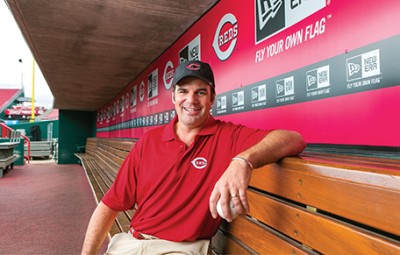
Photo: Matthew Allen
Phil Castellini ’92, COO of the Cincinnati Reds, at Great American Ball Park, the team’s home field.
Running a Major League Baseball team is not like running a typical company. An obvious statement, perhaps, but worth stating anyway. With tens of thousands of fans having a vested interest in what and how a team is doing, a major league franchise may be a business, but it’s also an institution and a source of civic pride. “Our philosophy is we are stewards, not owners,” says Phil Castellini ’92, COO of the Cincinnati Reds.
Castellini runs the business side of the Reds. Decisions about players are handled on the baseball side of the house, but otherwise Castellini oversees everything else, from IT and HR to marketing and ballpark operations. He has been with the Reds since 2006, when his father, Reds CEO Bob Castellini, led a group of investors to buy the team. As they took over the Reds, the Castellinis realized their profiles were about to become a lot more visible. Reporters would be asking them questions, something that didn’t happen in their prior experience in the food industry. To prepare, they did interview simulations with a local marketing firm. “We went through what we call ‘charm school,’” Castellini says. “By far, the strangest part of this job is having to do TV or radio. That was the most difficult part getting used to.”

Photo: Matthew Allen
Of Castellini’s many responsibilities as COO, ticket sales is among the biggest. For the Reds to compete, the team needs to fill the ballpark. That’s because the Cincinnati area ranks as one of the smallest markets in baseball, which puts the Reds at a disadvantage. The value of its local TV contract falls far below that of bigger market teams, leaving the Reds with less money to spend on player contracts. “It’s David versus Goliath,” Castellini says. “It’s tough to be competitive.” But ticket sales can help make up the difference. Get people in the park, and they also will spend money on merchandise and concessions. “There’s a lot of revenue potential there, tens of millions of dollars,” says Castellini.
Attendance has risen steadily since the Castellinis took over the team, and this year the Reds hope to draw 2.6 million fans through the gates at Great American Ball Park. Last year, the team drew 2.5 million, which ranked it 15th out of 30 clubs for attendance. “It’s not bad,” Castellini says. “It puts us right in the middle of the pack.” He’s also quick to point out that the St. Louis Cardinals, a perennial power and division rival, drew some 800,000 more fans than the Reds last year. “We’ve a long way to go to match our competitors,” he says.
To attract more fans to the park, the team installed a $14 million high-definition video screen, and Wi-Fi will be available throughout Great American this year. The ballpark also features fare from local restaurants and a craft-beer bar with 60 taps. “I want to give fans the best experience,” Castellini says.
On game nights, Castellini can be found all throughout Great American. For the pregame festivities, he’s on the field greeting guests, and in the first few innings he’s visiting sponsors and large groups, thanking them for their support. After the meeting and greeting is done, Castellini settles into a suite to finish paperwork and watch the rest of the game. While his job concentrates on the team’s business operations, he is also a fan, and, like any fan, he cares about what happens on the diamond. “I’m at every game till the end,” he says.
Castellini knows that the Reds ultimately are measured, not by the balance sheet, but by wins and rings. He dreams of the Reds returning to the glory years of the 1970s, when the team dominated and was known as the Big Red Machine. After a slew of losing seasons, the Reds have made the playoffs three times in recent years, but the team has fallen short of the sweetness of a World Series. As Castellini puts it, “We’re poking our noses against the bakery window.”—John Crawford
